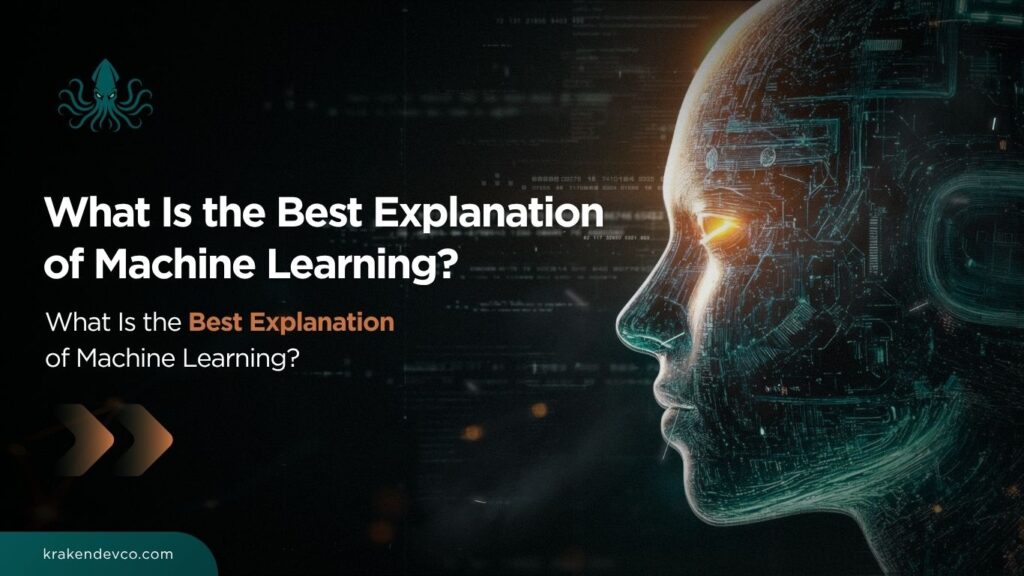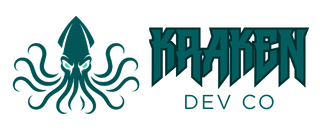
The Kraken Dev Co Breakdown for Builders Who Ship
At Kraken Dev Co, we don’t mythologise machine learning—we deploy it. Forget the fluff. This is machine learning explained for developers, engineers, CTOs, and decision-makers shipping real products in real environments.
Machine learning (ML) isn’t magic. It’s pattern recognition at scale, driven by maths, code, and raw data. If your software is just executing logic, you’re not using ML. If it’s adjusting based on outcomes, you’re in the game.
What Machine Learning Really Does
Machine learning models learn from data, not rules. That means:
- You don’t define every condition.
- You feed it training data—structured or unstructured—and let the algorithm find patterns.
- It builds a predictive model that improves over time through feedback loops and retraining.
Every ML system follows a core loop:
- Input layer: Take in features (sensor logs, user clicks, pixel grids, text tokens).
- Decision process: Run a prediction using a machine learning algorithm.
- Output layer: Deliver a result—classification, regression, or recommendation.
- Error calculation: Use a cost function to measure how wrong the prediction was.
- Optimisation: Apply gradient descent to adjust model weights.
- Repeat: Train again using updated data and feedback.
That’s the loop that powers everything from email filters to autonomous vehicles.
The Four Primary Types of Machine Learning
Different problems need different learning strategies:
Supervised Learning
- Trained on labelled datasets.
- Great for fraud detection, image recognition, and email spam classification.
- Algorithms: decision trees, logistic regression, support vector machines, classification algorithms.
Unsupervised Learning
- Works on unlabelled data sets.
- Finds hidden patterns, clusters, or dimensionality reduction.
- Think: k-means clustering, principal component analysis.
Semi-Supervised Learning
- Uses a small amount of labelled data with a larger pool of unlabelled data.
- Cuts costs in labelling while retaining accuracy.
- Common in speech recognition and medical imaging.
Reinforcement Learning
- Learns through trial, error, and reward.
- Backbone of self-driving cars, robotics, and game AI.
- Often paired with deep neural networks for complex environments.
Machine Learning vs Neural Networks vs Deep Learning
Let’s get precise.
| Term | What It Means | Ideal For | Data Demand |
| Machine Learning | All data-driven model types | Most business problems | Moderate |
| Neural Networks | Layered models mimicking neurons | Computer vision, speech | High |
| Deep Learning | Deep Neural Networks (many hidden layers) | NLP, generative AI, big data | Very High |
All deep learning uses neural networks, but not all ML does. Use only what your workload justifies.
Real Algorithms in Real Systems
Here’s what goes into production—beyond theory:
- Linear regression: For numerical predictions (e.g., housing price estimation).
- Logistic regression: Binary classification (e.g., will a user convert?).
- Support Vector Machines: Best for clean, high-margin classification problems.
- Decision Trees and Random Forests: Easy to interpret, fast to train.
- Neural Networks: Especially for voice assistants, image classification, or generative AI applications.
- K-Means: Segmenting unlabelled customer groups.
You’ll also encounter tree-based models like Classification And Regression Trees (CART) and advanced recommendation algorithms in recommender systems.
What Shipping ML Looks Like
You won’t find this in a textbook:
- Collect relevant internal data, sensor logs, and public data sets.
- Clean and normalise it.
- Apply feature engineering to extract signal from noise.
- Choose a model based on goals (speed, accuracy, interpretability).
- Train using frameworks (TensorFlow, PyTorch, Scikit-learn, Jupyter Notebooks).
- Validate performance on a test set.
- Deploy—into cloud platforms (Google Cloud, AWS SageMaker, Amazon Bedrock, Amazon Q).
- Monitor and retrain as needed.
This is ML in production—always iterative, never static.
Where You Already Use ML (Even If You Don’t Know It)
- Voice recognition: Siri, Alexa, Google Translate.
- Natural language processing: Chatbots, content moderation, natural language search.
- Recommendation engines: Netflix, Spotify, Amazon product suggestions.
- Computer vision: Facial recognition, optical character recognition (OCR), medical imaging.
- Data analysis: Predictive models in sales forecasting or churn analysis.
- Customer service: AI-powered email triage and response generation.
- Security: Intrusion detection and real-time risk scoring.
From big data pipelines to embedded systems—ML is under the hood.
Advantages and Boundaries
Strengths
- Scale: Parse millions of inputs in real time.
- Adaptability: Models evolve with new data.
- Precision: Better than rule-based systems for pattern-heavy tasks.
- Efficiency: Handles complexity humans can’t.
Limitations
- Bias: ML models mirror biased training data.
- Interpretability: Especially in deep learning, models become black boxes.
- Context blindness: Machines process signals—not meaning.
- Energy cost: Deep learning requires massive compute.
- Accountability: An AI system can’t be held responsible—humans must be.
Human Oversight Is Not Optional
Good machine learning doesn’t automate everything—it clarifies where human intervention matters:
- Define what problems matter.
- Audit your data pipelines.
- Interrogate predictions.
- Set escalation rules.
ML without human context is a risk. Keep a human in the loop—or risk mission failure.
Deploying at Scale? Your Stack Matters
Choose tools that match your compliance, latency, and MLOps needs:
- Cloud platforms: Google Vertex AI, AWS SageMaker, Azure ML.
- Foundational tools: TensorFlow, PyTorch, Scikit-learn.
- Data management: Amazon Textract, Amazon Kendra.
- Generative AI tooling: Amazon Bedrock, Google Cloud foundation models.
Look for native support for ML workloads, CI/CD, data privacy features, and structured/unstructured data ingestion.
Machine Learning ≠ Human Intelligence
ML doesn’t “think”. It doesn’t “know”. It maps input to output—nothing more.
A machine trained to detect tumours doesn’t understand cancer. It detects image patterns statistically associated with disease outcomes. That’s not consciousness. That’s computation.
Confusing the two leads to hype cycles, over-reliance, and real-world harm.
Classic Case: Matchboxes That Learn
Want to teach reinforcement learning? Use matchboxes.
The MENACE model—a set of matchboxes that “learns” how to play noughts and crosses—illustrates core ML concepts with zero code. Just state tracking, reward-based updating, and iteration.
At Kraken Dev Co, we build systems like this—but scaled to serve millions.
From Academic Concept to Business Infrastructure
ML’s not an R&D playground anymore. It’s critical infrastructure. We’ve deployed ML in:
- Fraud detection in financial systems
- Generative AI for document automation
- Voice assistants for enterprise workflows
- Predictive maintenance via sensor analysis
- Real-time NLP in security applications
- Autonomous vehicle decision stacks
- Disease diagnosis in healthcare systems
This isn’t experimentation. It’s deployment. That’s Kraken Dev Co.
Kraken Dev Co Builds Learning Machines—For Real
Machine learning isn’t about buzzwords. It’s about results.
- We architect systems that learn.
- We optimise for throughput, accuracy, and interpretability.
- We build for scale—across cloud-native stacks and embedded systems.
- We bring deep learning to production, with discipline.
Ready to ship learning systems that do more than demo well? Talk to Kraken Dev Co. We build what others pitch.



